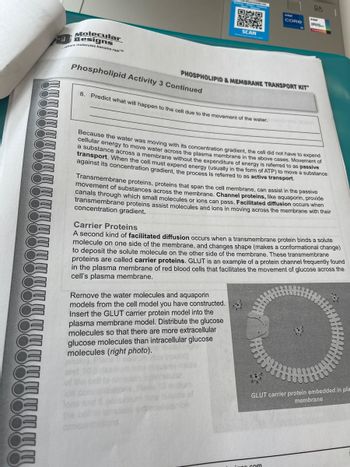
Human Anatomy & Physiology (11th Edition)
11th Edition
ISBN: 9780134580999
Author: Elaine N. Marieb, Katja N. Hoehn
Publisher: PEARSON
expand_more
expand_more
format_list_bulleted
Concept explainers
Question
Please see the picture below

Transcribed Image Text:000000000
Mesionar
where molecules become real™
Phospholipid Activity 3 Continued
90
KLA
OXCA
SCAN
PHOSPHOLIPID & MEMBRANE TRANSPORT KIT
8. Predict what will happen to the cell due to the movement of the water.
Instal
CORE
Remove the water molecules and aquaporin
models from the cell model you have constructed.
Insert the GLUT carrier protein model into the
plasma membrane model. Distribute the glucose
molecules so that there are more extracellular
glucose molecules than intracellular glucose
molecules (right photo).
Bo
Because the water was moving with its concentration gradient, the cell did not have to expend
cellular energy to move water across the plasma membrane in the above cases. Movement of
a substance across a membrane without the expenditure of energy is referred to as passive
transport. When the cell must expend energy (usually in the form of ATP) to move a substance
against its concentration gradient, the process is referred to as active transport.
IRIS
Transmembrane proteins, proteins that span the cell membrane, can assist in the passive
movement of substances across the membrane. Channel proteins, like aquaporin, provide
canals through which small molecules or ions can pass. Facilitated diffusion occurs when
transmembrane proteins assist molecules and ions in moving across the membrane with their
concentration gradient.
Carrier Proteins
A second kind of facilitated diffusion occurs when a transmembrane protein binds a solute
molecule on one side of the membrane, and changes shape (makes a conformational change)
to deposit the solute molecule on the other side of the membrane. These transmembrane
proteins are called carrier proteins. GLUT is an example of a protein channel frequently found
in the plasma membrane of red blood cells that facilitates the movement of glucose across the
cell's plasma membrane.
juns com
GLUT carrier protein embedded in pla
membrane
Expert Solution
This question has been solved!
Explore an expertly crafted, step-by-step solution for a thorough understanding of key concepts.
Step by stepSolved in 2 steps

Knowledge Booster
Learn more about
Need a deep-dive on the concept behind this application? Look no further. Learn more about this topic, biology and related others by exploring similar questions and additional content below.Similar questions
- Complete or fill out the rest of the punnett square in the imagine provided.arrow_forwardplease explan each question in detail and please do not copy any thing form internet please 1,What are diet pills / diet? 2,Do these pills/diet result in effective short term and long-term weight loss? why OR why not. 3,what health risks are associated with these types of pills/diet. 4,Risk / benefit associated withthese types of weight loss pills. 5,What effect does the low-calorie diet have on metabolism? 6,How are these factors effecting society? 7,why and when to change your diet, it's important to know how the cells in your body will react to the introduction of new substances or the removal of other substance. 8,Help me understand how i can incorporate any changes i made into your everyday life 9,What important factor would i make to aware of regrading the use of weight loss pill 10, the dangers of extremely low-calorie diet and to promote healthy eating habits and to maintain a healthy weight.arrow_forwardWhy is it so important to have accurate medical billing and coding.arrow_forward
- Please write what you see in the picture in a sentence or two.arrow_forwardCan you please tell me all the parts in the picture? Please just label them clearly thank you.arrow_forwardPlease label subparts as per: https://www.bartleby.com/questions-and-answers/2-3/a4e8137f-8ffd-4f93-ac94-ae6d805c0705arrow_forward
arrow_back_ios
arrow_forward_ios
Recommended textbooks for you
 Human Anatomy & Physiology (11th Edition)BiologyISBN:9780134580999Author:Elaine N. Marieb, Katja N. HoehnPublisher:PEARSON
Human Anatomy & Physiology (11th Edition)BiologyISBN:9780134580999Author:Elaine N. Marieb, Katja N. HoehnPublisher:PEARSON Biology 2eBiologyISBN:9781947172517Author:Matthew Douglas, Jung Choi, Mary Ann ClarkPublisher:OpenStax
Biology 2eBiologyISBN:9781947172517Author:Matthew Douglas, Jung Choi, Mary Ann ClarkPublisher:OpenStax Anatomy & PhysiologyBiologyISBN:9781259398629Author:McKinley, Michael P., O'loughlin, Valerie Dean, Bidle, Theresa StouterPublisher:Mcgraw Hill Education,
Anatomy & PhysiologyBiologyISBN:9781259398629Author:McKinley, Michael P., O'loughlin, Valerie Dean, Bidle, Theresa StouterPublisher:Mcgraw Hill Education, Molecular Biology of the Cell (Sixth Edition)BiologyISBN:9780815344322Author:Bruce Alberts, Alexander D. Johnson, Julian Lewis, David Morgan, Martin Raff, Keith Roberts, Peter WalterPublisher:W. W. Norton & Company
Molecular Biology of the Cell (Sixth Edition)BiologyISBN:9780815344322Author:Bruce Alberts, Alexander D. Johnson, Julian Lewis, David Morgan, Martin Raff, Keith Roberts, Peter WalterPublisher:W. W. Norton & Company Laboratory Manual For Human Anatomy & PhysiologyBiologyISBN:9781260159363Author:Martin, Terry R., Prentice-craver, CynthiaPublisher:McGraw-Hill Publishing Co.
Laboratory Manual For Human Anatomy & PhysiologyBiologyISBN:9781260159363Author:Martin, Terry R., Prentice-craver, CynthiaPublisher:McGraw-Hill Publishing Co. Inquiry Into Life (16th Edition)BiologyISBN:9781260231700Author:Sylvia S. Mader, Michael WindelspechtPublisher:McGraw Hill Education
Inquiry Into Life (16th Edition)BiologyISBN:9781260231700Author:Sylvia S. Mader, Michael WindelspechtPublisher:McGraw Hill Education

Human Anatomy & Physiology (11th Edition)
Biology
ISBN:9780134580999
Author:Elaine N. Marieb, Katja N. Hoehn
Publisher:PEARSON

Biology 2e
Biology
ISBN:9781947172517
Author:Matthew Douglas, Jung Choi, Mary Ann Clark
Publisher:OpenStax

Anatomy & Physiology
Biology
ISBN:9781259398629
Author:McKinley, Michael P., O'loughlin, Valerie Dean, Bidle, Theresa Stouter
Publisher:Mcgraw Hill Education,

Molecular Biology of the Cell (Sixth Edition)
Biology
ISBN:9780815344322
Author:Bruce Alberts, Alexander D. Johnson, Julian Lewis, David Morgan, Martin Raff, Keith Roberts, Peter Walter
Publisher:W. W. Norton & Company

Laboratory Manual For Human Anatomy & Physiology
Biology
ISBN:9781260159363
Author:Martin, Terry R., Prentice-craver, Cynthia
Publisher:McGraw-Hill Publishing Co.

Inquiry Into Life (16th Edition)
Biology
ISBN:9781260231700
Author:Sylvia S. Mader, Michael Windelspecht
Publisher:McGraw Hill Education